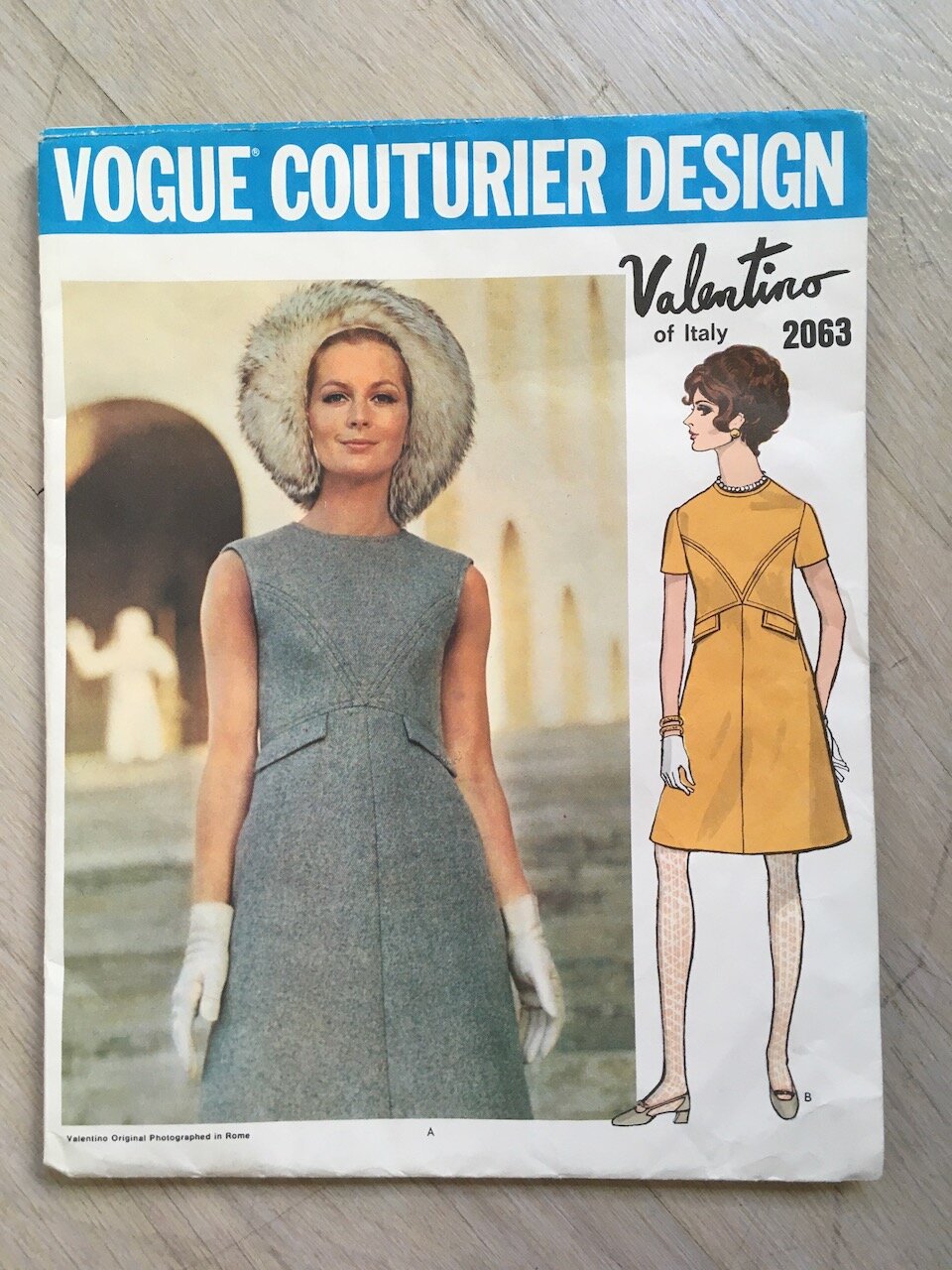Vintage Vogue Designer Patterns
In the summer I won an ebay auction of assorted sewing notions, which included this Vogue Paris Original Dior dress pattern. Since then, I’ve been spending a lot of time browsing ebay for and occasionally bidding on vintage Vogue patterns.
Contemporary Vogue Patterns
Vogue has a long history of licensing designer fashions and making patterns and instructions to recreate runway looks for home garment sewists. Today’s catalog includes licensed looks from Badgley Mishka and Rachel Comey, among others, and patterns inspired by current designer runway looks.
I own a few contemporary Vogue designer patterns but haven’t completed any one yet. I have no gown-worth events coming up, so I figure I can continue kicking these projects to the back of my sewing queue. I do have the muslin for this Rachel Comey dress cut out and sitting in my half finished project pile, but it’s not bothering me this year while I stay at home.
Vogue has also reissued some 1940s and 1950s patterns with contemporary sizing. I own a few of these too but have not made them. Mostly I’ve just marveled at how much fabric is called for to make a full circle skirt.
Vintage Sewing Patterns
The vintage Vogue patterns are interesting to me because I am curious about older, no longer contemporary sewing techniques that they call for. I don’t wear vintage clothing myself. However I enjoy “looking under the hood” of vintage garments to see how they were constructed. I’ll find things like waist stays or hand hemmed raw seams that don’t show up in contemporary pattern instructions or ready to wear garments. My vintage sewing notion lot from ebay also included some hem tape, which I had to look up on the internet in order to figure out how to use it. Also, I like thinking about what a home sewist 70 years ago would have done if they were making the same garment. Would they also be listening to a podcast or the radio while ripping out some weird seams?
Vintage Vogue Patterns
Vintage Vogue designer patterns often come in a larger envelope, with the designer name prominently on display. There are a few series names for these special patterns- Vogue Paris Original, Vogue Couturier, Vogue Americana, Vogue Special Design, and more. You can also find vintage non-designer Vogue patterns, which include more garments for everyday wear and come in a regular size envelope with an illustrated cover. The designer patterns can get surprisingly expensive in auction but I have been able to find some deals, especially on patterns that are not in mint condition, but in good enough shape to sew.
As far as I can tell, Vogue Paris Original patterns start from the 1960s. The really old ones have black and white photos on the envelope with a red, white and blue label. A lot of these patterns include a dress and a matching jacket, maybe even a neckerchief or scarf to sew in the same fabric. You would really be creating a whole look for yourself by sewing these patterns! The later patterns have a color photo on the cover of a model wearing the full outfit, often accessorized to the max with kid gloves and a huge hat. Maybe you, the home sewist, were supposed to go out and buy the accessories after all that sewing, to really make it fashion? The models are also posing in an urban setting and I like to imagine they are on their way to a most glamorous coffee date. The front of the envelope also shows fashion illustrations of alternate views, for example if the pattern could be made with full sleeves, or in a different skirt length.
I like how the bodice pieces form a “V” for Valentino
Vogue Couturier patterns seem to start around the late 1960s. These are my favorite to browse, because the style lines are clean but also surprising. The dress bodice piecing often goes beyond the bust dart, waist dart, princess seams, that I’m familiar with. I wonder if the designers came up with new names for the bust shaping, like The Starfish or The Anvil. I can also imagine myself wearing some of these looks without feeling like I’m wearing a costume.
Vogue Americana and Vogue American Designer seem to focus on American designers and run from the early 1970s through the 1990s. There are also a lot of cool looks here, especially with a more relaxed fit and outfits sewn with knits.
The back of the vintage Vogue envelopes have the sizing info (these patterns were sold in one size per envelope), yardage (I did not know that 35” wide fabric was a thing), measurements, and fabric suggestions (often times “wool”). Inside the envelope are the instructions and the pattern, as well as a sew-in label for your finished garment!
From reading through the instructions, I think Vogue assumed that you already had some sewing chops and knew what you were doing. The instructions are pretty scant, like “make bound buttonhole”, and that is all you get for step 14. But I think this would be a fun challenge to make one of these vintage patterns, and definitely a learning experience. It would be a confidence builder to know that you could make a garment for yourself from a piece of history.
More info, if you want to get lost in a rabbit hole
Closet Core patterns has an old blog post that rounds up some of these vintage looks.
Here is an archive article about the Vogue Paris Original patterns.
If you stumble across one of these patterns in a thrift store and the envelope is missing, you can look up the original envelope photo and back of envelope description on this website.
This blog also has a lot of info about contemporary and vintage sewing patterns



